
This course offers an introduction to the basic concepts of the quantum theory of solids.
- Subject:
- Physical Science
- Physics
- Material Type:
- Full Course
- Provider Set:
- MIT OpenCourseWare
- Author:
- Wen, Xiao-Gang
- Date Added:
- 09/01/2006

This course offers an introduction to the basic concepts of the quantum theory of solids.

This resource contains 95 multiple choice quiz questions inspired by Examples in the 12 chapters of University Physics Volume 2 Unit 2: Electricity and Magnetism. The quizzes have randomized numerical values, and can be printed out in two versions for students sitting side-by-side in a classroom. The current configuration creates 3-question quizzes. A study guide leads students to a practice quiz for each chapter. The number of questions in the study guide ranges from 4 to 11. The small number of questions in certain chapters does not imply that these chapters are less important -- not all examples make for good multiple choice test questions that involve numerical calculations. After this system has been field tested, more questions can be added where needed. Conceptual questions can also be added.
The selection of 3 questions from a given chapter was achieved by a random number generator. For this reason, the question selections might be less than ideal. These quizzes are not intended to have a large impact on the students' grade, but instead to encourage students to *read the textbook*. Also, since instructors know the contents of the quizzes in advance, they can compensate for idiosyncratic question selection as they prep students for the quiz.
The advantage of this system is that it is extremely convenient for instructors to use the browser's "print" option to print and distribute a quiz to the students. The disadvantage is that students and instructor have equal access to everything. Fortunately we can "hide the quizzes in plain sight". The current configuration provides 20 "renditions" of each quiz, and only the instructor knows which is selected.
The transparent nature of this unorthodox system has some advantages: Traditional methods of hiding the content of upcoming classroom exams are plagued by the fact that it is difficult to keep information secret. Instructors who use the same or similar exams for consecutive years will discover that students begin to exchange information with each other between semesters. An even more intractable problem is that testbank questions can be purchased on the internet. In this regard, the OER efforts might gain advantage over commercial ventures that sell text questions to instructors or students. The legitimate vendors (who sell to instructors) attempt to solve the "secrecy" problem by continuously modifying the textbooks, exams, and other ancillary materials. While all this ensures future revenues for the vendors, it also perpetuates costs for students.
In contrast, there is no need to modify an OER textbook by artificially creating a "new" edition. In fact, it is my experience that OER are created at a painfully slow pace, so it is unlikely that OER materials could evolve even if we wanted them to. This relatively "static" nature of OER textbooks suggests that the exams and homework problems be also "static". Instead of asking students to solve a homework problem at home, they should be quizzed on their ability to solve a problem whose solution is readily available online. Unfortunately all this tends to reduce the quality of lessons to that of rote memorization. So instead of finding interesting homework problems for which there is not solution available on the internet, we should task students with creating new homework problems and test questions. Those with less ability can be tasked with improving the posted solutions to problems that have already been solved.
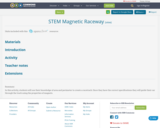
In this activity, students will use their knowledge of area and perimeter to create a racetrack. Once they have the correct specifications they will guide their car through the track using the properties of magnets.
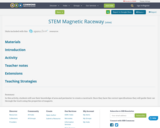
In this activity, students will use their knowledge of area and perimeter to create a racetrack. Once they have the correct specifications they will guide their car through the track using the properties of magnets.
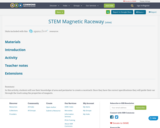
In this activity, students will use their knowledge of area and perimeter to create a racetrack. Once they have the correct specifications they will guide their car through the track using the properties of magnets.
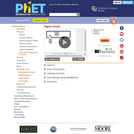
Why do the lights turn on in a room as soon as you flip a switch? Flip the switch and electrons slowly creep along a wire. The light turns on when the signal reaches it.
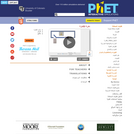
Why do the lights turn on in a room as soon as you flip a switch? Flip the switch and electrons slowly creep along a wire. The light turns on when the signal reaches it.

In this activity, learners create a tiny electric, motorized dancer. Learners use the interactions of magnetism and electric current to make a wire spin, while displaying the Lorentz Force in action. This lesson guide provides one of many ways to build the spinner and links to other methods.
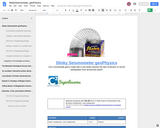
This unit uses the slinky seismometer as a means of studying physics concepts such as waves, sound and the speed of sound vs speed of light, resonance, electricity and magnetism, Lenz Law and magnetic dampening (backwards engineering). Students experiment with the basic parts of the seismometer and either build or connect the seismometer to the internet to take and upload data.
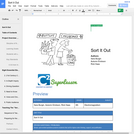
In this project, students will use knowledge of electricity and electromagnetism to collaboratively design and test a model of a magnetic recycling sorter. They will evaluate the performance of their models and propose further modifications based on the output of their magnetic device measured in mT using a Vernier probe. They will also physically test their magnets on a model of a conveyor belt containing recyclable items. Students will track their data from both tests, with the ultimate goal of creating the strongest and most effective magnet with given materials. Finally, students will present their findings and proposed final design to peers and community partners involved in the recycling industry. The entire process takes about 6 weeks. The unit is a great fit for standards within energy and engineering & design.

This course offers an introduction to probability, statistical mechanics, and thermodynamics. Numerous examples are used to illustrate a wide variety of physical phenomena such as magnetism, polyatomic gases, thermal radiation, electrons in solids, and noise in electronic devices.
This course is an elective subject in MIT’s undergraduate Energy Studies Minor. This Institute-wide program complements the deep expertise obtained in any major with a broad understanding of the interlinked realms of science, technology, and social sciences as they relate to energy and associated environmental challenges.

The Sunspotters program of the Student Observation Network (SON) is excellent for grades K +12. There are activities for all grades available. You or your students may think of other questions to investigate that can lead to open inquiry by using live and archived data. By collecting and analyzing real-time data from student telescopes, professional observatories, and NASA satellites, they can carry out the same duties as NASA researchers!
In Sunspotters you will learn:
How to instruct students in the construction and use of simple solar telescopes to observe sunspots and to predict which sunspots are most likely to produce solar flares or coronal mass ejections,
How to enable students to obtain and interpret data from ground-based professional observatories,
How to enable students to obtain and interpret data from NASA satellites.

This is the second term of a theoretical treatment of the physics of solids. Topics covered include linear response theory; the physics of disorder; superconductivity; the local moment and itinerant magnetism; the Kondo problem and Fermi liquid theory.
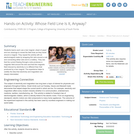
Students teams each use a bar magnet, sheet of paper and iron shavings to reveal the field lines as they travel around a magnet. They repeat the activity with an electromagnet made by wrapping thin wire around a nail and connecting either wire end to a battery. They see that the current flowing through a wire produces a magnetic field around the wire and that this magnetic field induced by electricity is no different than that produced by a bar magnet. The experience helps to solidify the idea that electricity and magnetism are deeply interrelated.
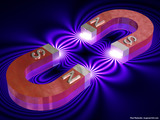
सादरीकरणा नंतर तुम्हाला समजण्यास मदद होईलv चुंबकत्व संकल्पनाv चुंबकाचे गुणधर्म v चुंबकाचे प्रकारv चुंबकाचे उपयोग